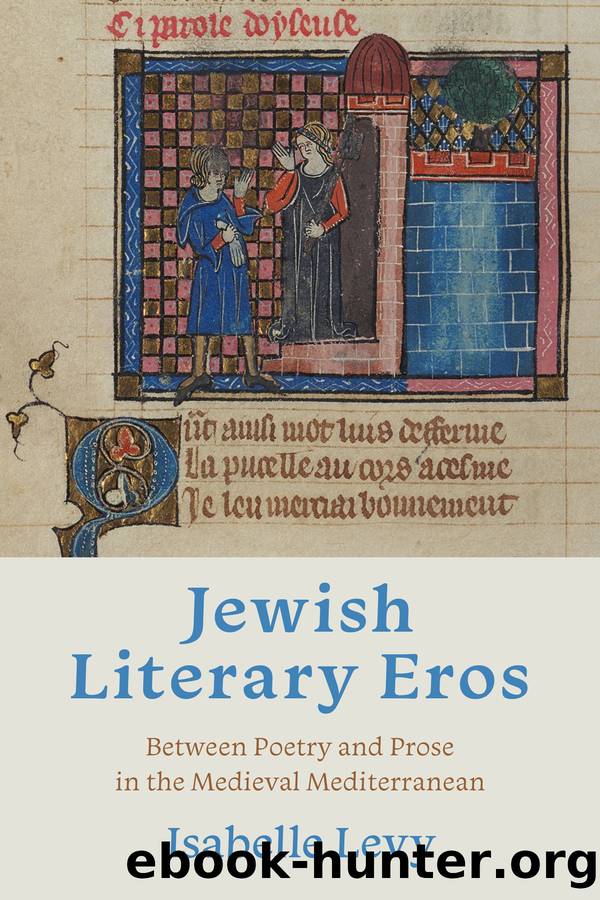Jewish Literary Eros by Isabelle Levy;

Author:Isabelle Levy; [Levy;, Isabelle]
Language: eng
Format: epub
ISBN: 9780253060174
Publisher: IndianaUP
Published: 2022-02-12T00:00:00+00:00
The Prosification of Metaphor
Though the phenomenon of metaphors in prose bears resemblance to metalepsis/ transumption, metonymy, and synecdoche, no rhetorical term seems to fit it perfectly.2 Instead, I use the term concrete metaphor to represent this particular use of metaphor in this particular literary time and space. I define this practice via both textual examples and a discussion of relevant medieval theories of metaphor. It is easier to explain what a concrete metaphor is not than what it is: it is not an instance of concrete poetryââa work that has been composed with specific attention to graphic features such as typography, layout, shape, or distribution on the pageâânor is it carmina figurata (Lat. âshaped songsâ), the equivalent of concrete poetry in reference to ancient and medieval poems whose graphical features partner with the words, such as the Hebrew tree-shaped poem by twelfth-century poet and exegete Abraham ibn Ezra.3
A concrete metaphor might be termed the opposite of a dead metaphor, âan expression that was originally metaphorical but no longer functions as a trope and is not understood literally.â4 In fact, a concrete metaphor stands opposite the dead metaphor Mordechai Cohen detects in Maimonidesâs Guide, used there to distinguish between metaphor and allegory so that the reader can immediately accept scriptural metaphor and move on to deeper understanding.5 In the case of our Hebrew maqamas, the prose halts this process: it brings to life the dead metaphor in the process of transferring it from poetry to prose. Phrases in prose that have long since lost their literal meaning in poetry, such as the burning liver as a sign of lovesickness, are reappropriated when translated across forms, and in the new context, they urge the reader to pause and reconsider the meaning.
This rebirth in metaphorical prose is analogous to that in the earliest devotional Hebrew lyrics of al-Andalus that incorporated themes and meters from secular poetry, which initially came as a shock to the uninitiated. When moved out of its original genre or form, a dead metaphor comes to life and jars the reader, momentarily allowing the unexpected to enter, as in Aristotleâs âwhite milkâ example.6 Aristotle goes on to say that once the novelty wears off, the metaphor in prose can linger as artificial and clumsy, even if it is laudable for its unpredictability: âThere is certainly a need for such epithets, because they give language the qualities of unfamiliarity and novelty, but a speaker should aim for moderation, because excess artificiality does more damage than no preparation at all. The latter is merely not good, but the former is actually bad.â7 But medieval Jewish authors toying with metaphors in the context of amorous prosimetra did not necessarily aim for moderationâespecially when the worth of Hebrew as a literary tongue was at stake. They instead aimed for something new, perhaps counting on the fact that once the reader exposed the artifice of the unexpected metaphor, the metaphor would again return to its figurative meaning, as they tend to do over time, for âthere is no clear-cut boundary between literal and figurative usage.
Download
This site does not store any files on its server. We only index and link to content provided by other sites. Please contact the content providers to delete copyright contents if any and email us, we'll remove relevant links or contents immediately.
The Power of Myth by Joseph Campbell & Bill Moyers(1000)
Half Moon Bay by Jonathan Kellerman & Jesse Kellerman(950)
A Social History of the Media by Peter Burke & Peter Burke(935)
Inseparable by Emma Donoghue(921)
The Nets of Modernism: Henry James, Virginia Woolf, James Joyce, and Sigmund Freud by Maud Ellmann(832)
The Spike by Mark Humphries;(764)
The Complete Correspondence 1928-1940 by Theodor W. Adorno & Walter Benjamin(746)
A Theory of Narrative Drawing by Simon Grennan(741)
Culture by Terry Eagleton(709)
Ideology by Eagleton Terry;(696)
Bodies from the Library 3 by Tony Medawar(679)
World Philology by(673)
Farnsworth's Classical English Rhetoric by Ward Farnsworth(671)
Game of Thrones and Philosophy by William Irwin(668)
High Albania by M. Edith Durham(654)
Adam Smith by Jonathan Conlin(647)
A Reader’s Companion to J. D. Salinger’s The Catcher in the Rye by Peter Beidler(642)
Comic Genius: Portraits of Funny People by(616)
Monkey King by Wu Cheng'en(609)
